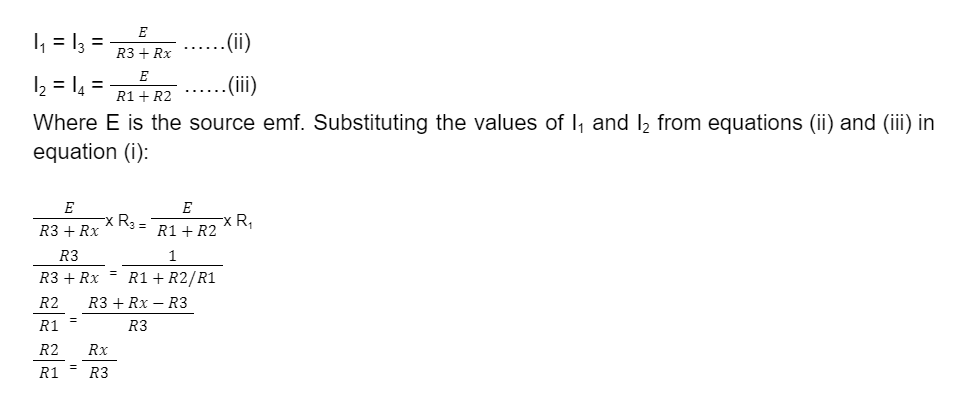A Wheatstone bridge is an electrical circuit. It is used to find an unknown electrical resistance by balancing two legs of a bridge circuit. One of the two legs contains an unknown resistance. The main advantage of the circuit is its ability to provide very accurate measurements. It was invented by Samuel Hunter Christie in 1833 and further improved by Sir Charles Wheatstone in 1843. The Wheatstone bridge circuit is an application of Kirchhof’s laws of electrical circuits.
Wheatstone Bridge Principle
Wheatstone bridge is based on a principle called null deflection, i.e. the resistance ratios are equal and there is no flow of current through the circuit. Under normal circumstances, the bridge is unbalanced when there is a flow of current through the galvanometer. The bridge is said to be balanced when there is no flow of current through the galvanometer. This condition is achieved by adjustment of the known and the variable resistance.
Wheatstone Bridge Construction
The Wheatstone Bridge consists of four legs in which four resistances are connected (one in each leg). A source and a null detector (galvanometer) are connected between points AC and BD, respectively. The legs with resistances R1 and R2 are known as ratio legs. The resistance R3 is the standard resistance and R4 is the unknown resistance to be found.
Wheatstone Bridge Working
Based on the null deflection principle, if the bridge is unbalanced, there will be a potential difference between points B and D, which will cause the flow of current through the galvanometer. To attain a balanced condition, the known resistance and the variable resistance need to be varied.
Wheatstone Bridge Formula
The Wheatstone Bridge Formula is used to find out the unknown resistance in the circuit. It can be derived as per the following steps:
Suppose
- R1 = Resistance of leg AD
- R2 = Resistance of leg CD
- R3 = Resistance of leg AB
- Rx = Resistance of leg BC
- E = Source
- G = Galvanometer (Detector)
The bridge is balanced when the voltage across points A and D equals the potential difference between points A and B so that the potential difference in the galvanometer or the leg BD is zero. Hence, there is no current flow through the galvanometer. Thus there is no deflection in it.
Under balancing condition, the voltage across AB will be equal to the voltage across AD i.e.
I1 R3 = I2 R1 ……(i)
When the bridge is balanced, the following equations also hold true:

Hence, Rx= R3 x R2/R1 ……(iv)
where
- Rx = Unknown resistance
- R2 = Standard resistance
- R1, R3 = Ratio of the leg of the bridge
The above expression (iv) is the Wheatstone bridge formula. It is an equation of Wheatstone bridge under balanced condition. Hence, from this expression, the value of unknown resistance R can be measured if the resistances in the other three legs, i.e., R1, R2 and R3, are known.
Wheatstone Bridge Applications
- Accurate measurement of low resistance can be done by using the Wheatstone bridge.
- It is used to locate the cable fault in telephone companies.
- The Wheatstone bridge configuration can also be used with electrical sensors such as strain gauge, thermistor and LDR to measure strain, temperature and light.
- The Wheatstone bridge circuit can also be used to find out unknown capacitance and inductance.
Wheatstone Bridge Limitations
- The current flowing through the resistors causes a heating effect which results in the change of resistance of the bridge legs. This can be checked if the dissipation of power in the bridge legs is calculated beforehand. This ensures the flow of current within a safe value and thus prevents the heating effect.
- If the Wheatstone bridge is used to measure low resistance, the load and contact resistances become more significant, introducing error.
- If the Wheatstone bridge is used for high resistance measurements, the galvanometer fails to indicate the imbalance in the bridge. This is due to the resistance of the bridge becoming so high that the galvanometer becomes insensitive to the imbalance. This can be prevented by replacing the battery using a power supply and the galvanometer with a DC VTVM (Vacuum Tube Voltmeter). However, measurement in the range of megaohms resistances is not possible with a Wheatstone bridge.
Conclusion
A Wheatstone bridge is an electrical circuit. It is used to find an unknown electrical resistance by balancing two legs of a bridge circuit, where one of the two legs contains the unknown resistance. It consists of four legs in which four resistances are connected (one in each leg), a source and a null detector (galvanometer). It is based on the principle of null deflection, i.e. the resistance ratios are equal and there is no flow of current through the circuit. The unknown resistance can be measured by using the Wheatstone Bridge Formula.
 Profile
Profile Settings
Settings Refer your friends
Refer your friends Sign out
Sign out













